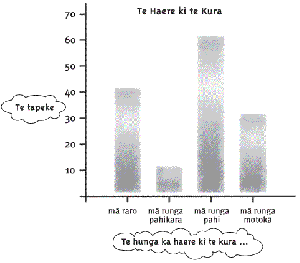He kākano i ruia
nā Tipene Watson
In this story the class studies car emissions. They identify car emissions as part of the cause of climate change. However, they also see how they can be part of the solution to the problem of climate change.
Ngā hononga ki te marautanga
Te Reo Māori i roto i te Marautanga o Aotearoa (wh. 60, 68, 77, 86, 95 me 103)
| Whenu | Whakarongo (Kōrero) |
| Kōeke | 3 |
| Whāinga paetae | Ka whakarongo, ka mārama, ka pāhekoheko te ākonga kia mau, kia roa ai ngā whiriwhiri ā-rōpū i ngā tūmomo horopaki ako katoa. |
| Pūkenga | Ko te maumahara, ko te whakautu i ngā ariā matua me ngā pātai e pā ana ki ngā horopaki e taunga ana te ākonga. |
| Whenu | Kōrero (Whakarongo) |
| Kōeke | 3 |
| Whāinga paetae | Ka taea e te ākonga te kōrero, te pātai, te whakaputa ōna ake whakaaro ki te hunga ākonga, ā, me raupapa, me mārama te kōrero. |
| Pūkenga | Ko te whakapuaki i ngā kōrero māmā hei whakaaritanga poto e kitea ai ngā mōhio e tika ana kia whakaaturia. |
| Whenu | Pānui (Tuhituhi) |
| Kōeke | 3 |
| Whāinga paetae | Ka taea e te ākonga te tīpako mai me te pānui ngā tuhinga hei whakangahau, hei whakaea hoki i ngā kaupapa kua whakaritea. |
| Pūkenga | Ko te tīpako i ngā ariā matua mai i ngā pānui. |
| Whenu | Tuhituhi (Pānui) |
| Kōeke | 3 |
| Whāinga paetae | Me mārama, me whai hua tā te ākonga tāna tuhi i ngā momo tuhinga huhua noa. |
| Pūkenga | Ko te tīpako i ngā momo tuhituhi e hāngai ana ki te kaupapa me te pūtake o te kōrero. |
| Whenu | Mātakitaki (Whakaatu) |
| Kōeke | 3 |
| Whāinga paetae | Ka mātakitaki, ka mārama te ākonga ki ngā momo reo ataata, reo ā-waha, me te mōhio anō ki te pānga o tētahi ki tētahi. |
| Pūkenga | Ko te auahatanga o te whakaaro reo ataata. |
| Whenu | Whakaatu (Mātakitaki) |
| Kōeke | 3 |
| Whāinga paetae | Ka taea e te ākonga te whakamahi ngātahi te reo ā-waha me te reo ataata kia puta ai ngā pānga e hiahiatia ana. |
| Pūkenga | Ko te tāutu i te pūtake o tētahi kōrero kia whakaaturia atu. |
Hei mahi
- Read the title to students. Use a Think, Pair, Share strategy and ask the students, “What is the author’s message?” List the students’ ideas. Have the students read the story and then discuss what they think the author’s message is. They should identify parts of the text that support their ideas.
- Students work in groups to create a jingle to demonstrate their understanding of the whakatauki, “Ahakoa he iti, he pounamu.” Their jingle needs to be related to the author’s message.
- Have the students write a summary of the main events from the story. In pairs they take turns to share their thoughts.
Aromatawai
Ka whakaatu i tana tohungatanga ki te:
- whakaputa mōhio kia mārama ai ki te kaipānui
- whakawhiti kōrero māmā.
He hononga ki te marautanga pāngarau
Pāngarau i roto i te Marautanga o Aotearoa (wh. 129)
| Whenu | Te tauanga |
| Taumata | 2 |
| Whāinga paetae | I roto i ngā horopaki whai tikanga, me mōhio te ākonga ki te kohi, ki te whakaatu raraunga whakarōpū, raraunga tauoti, ki te kauwhata whakaahua, ki te tūtohi tatau, ki te kauwhata pou kē rānei. |
Hei mahi
After reading the story, separate the class into groups. Have each group gather data about how students in their school travel to school. Have the students graph the data and develop a proposal for their school community that would minimize their vehicle exhaust emissions.
He hononga ki te marautanga hauora
Hauora i roto i te Marautanga o Aotearoa (wh. 32)
| Whenu | Te waiora |
| Taumata | 2 |
| Whāinga paetae | Ka taea e te ākonga te āhukahuka tana tipu haere, me ana hiahia i a ia e pakari haere ana, ka whakaatu ko ia anō kei te whakahaere i tētahi wāhanga nui o ngā mahi e ora ai ia. |
Students discuss the health benefits of finding alternative means of travel to and from school.




